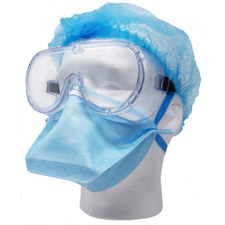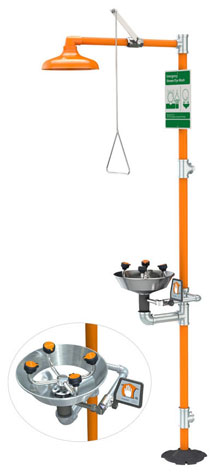| The Home page of ILPI's Safety Data Sheet (SDS) Resource, the leader in SDS information since 1995! | |
| The history and philosophy behind this resource. | |
| A curated collection of books and reference materials concerning Safety Data Sheets and closely related topics. | |
| Paste your plain text SDS into the SDS-Demystifier, and it will be converted into a hypertext-enriched document with links to detailed explanations of each key term. | |
| An extensive list of frequently asked questions about Safety Data Sheets including regulations, content, compliance, and more. | |
| A humorous take on Safety Data Sheet jargon. Fill in the blanks on our entry form to generate a personalized Unsafety Data Sheet to share with your coworkers. | |
| Since 1995, we've maintained this massive curated list of the best places to find Safety Data Sheets on the Internet. | |
| You are here! Way more than a glossary, this hypertext-enhanced resource covers hundreds of SDS-related terms and expert knowledge. Each entry includes both the SDS relevance and links to additional authoritative resources. | |
| Archived results of Safety Data Sheet related polls taken by some of our millions of site visitors | |
| The OSHA regulations behind SDS regulations, including the inspection guidelines and over 400 official interpretations letters under the Hazard Communication Standard | |
| Commercial suppliers of SDS authoring and management software as well as cloud compliance services. | |
| Commercial companies that will create SDS's for your specific needs as well as SDS translation companies. |

Safety signs, banners, and scoreboards? Get yours at Safety Emporium!

Get your US-manufactured NIOSH-approved N95 surgical respirators and more from Safety Emporium.
Definition
The Wilson RISK Scale of Material Hazards was a numeric rating system that assessed the following acute hazards:
- Reactivity (R)
- Inhalation (I)
- Skin contact (S)
- Kindling (fire) (K)
Additional Info
This system was unique to Material Safety Data Sheets (MSDSs) produced by New-York based Genium Publishing Corporation, which, from about 1995 to 2020, was a commercial publisher of hazardous materials information and MSDSs. In 2002, the firm became The Genium Group Inc., but it appears the company may have gone defunct in 2020.
The numbers on the Wilson RISK Scale ranged from 1 (or possibly 0) to 4 with 1 being the least hazard and 4 being the greatest hazard. In this context, it worked similarly to the HMIS and NFPA hazard rating systems.
Genium's web site once stated that the ratings represent "a material's degree of hazard based on documented values and/or the best judgments of certified industrial hygienists." However, we have found virtually no other publicly-accessible information about the scale itself or how one would assign RISK ratings to various substances. We tried contacting Genium on more than one occasion and received no reply. Based on a single reference (under Further Reading below), it appears these were the rating criteria for the scale:
| Rating | Reactivity |
| 1 | Stable at room temperature; may be unstable at elevated temperatures. |
| 2 | Unstable; may under-go rapid chemical change. Will not detonate. |
| 3 | Capable of detonation explosive decomposition or reaction but required heat or other agent to initiate these. |
| 4 | Readily capable of detonation or explosive decomposition or reaction at room temperature. |
| Rating | Inhalation |
| 1 | TLV >500 ppm (vapor) or >10 mg/m3 (solid) |
| 2 | TLV 101 to 500 ppm (vapor) or 1.1 to 10 mg/m3 (solid) |
| 3 | TLV 11 to 100 ppm (vapor) or 0.11 to 1.0 mg/m3 (solid) |
| 4 | TLV < 10 ppm (vapor) or < 0.1 mg/m3 (solid) |
| Rating | Skin Contact |
| 1 | Slight irritation; no tissue damage. |
| 2 | Mild irritation; tissue damage. |
| 3 | Severe irritation; tissue corrosion within short time period. |
| 4 | Corrosive to skin on contact. |
| Rating | Kindling |
| 1 | Flash point > 200 °F |
| 2 | Flash point 101 to 199 °F |
| 3 | Flash point 73 to 100 °F |
| 4 | Flash point < 73 °F |

Safety Emporium carries all kinds of eye/face washes, safety showers, drench hoses and more.
SDS Relevance
See above. This scale was unique to MSDS's produced by Genium Publishing Corporation. We find the Wilson RISK system unacceptable because of its proprietary nature and because the hazard classification system required by OHSA's Hazard Communication Standard has made this system obsolete.
In 2010, we conducted a random Google search of various Genium MSDS's, and it appears that Genium was either no longer using it as a standard part of their authoring suite or only used it for certain substances. By 2020, we could no longer find it used on any current SDS or safety-related document.
Thus, it appears the Wilson RISK scale is long-defunct at this point. If you have a sheet with this information on it, it was probably authored well before the current version of the Hazard Communication Standard took effect, and is likely obsolete.
Further Reading
We have found precisely one document that explained the criteria for the RISK scale rating (the source of the tables presented above).
- Dental Hygiene Program Policy and Procedures Manual 2015-2016, Section 2.25 which provides the scale limits presented above.
See also: CHIP, flammable, HMIS, NFPA, useless abbreviations.